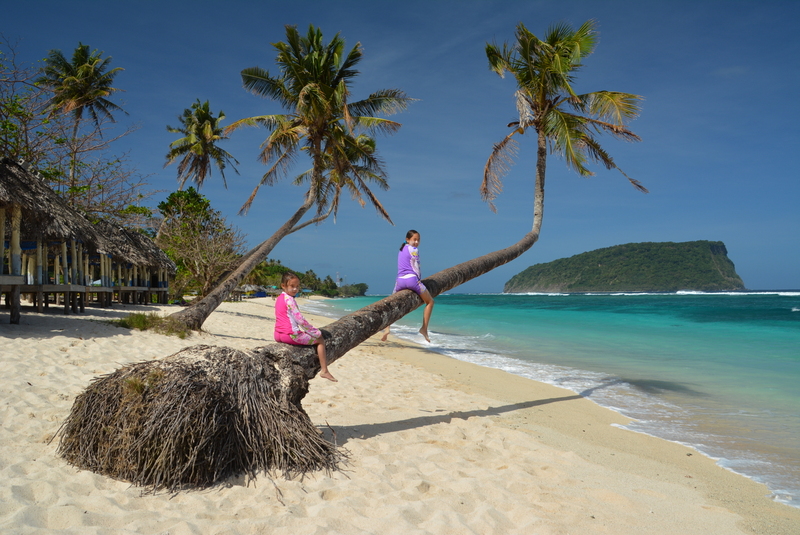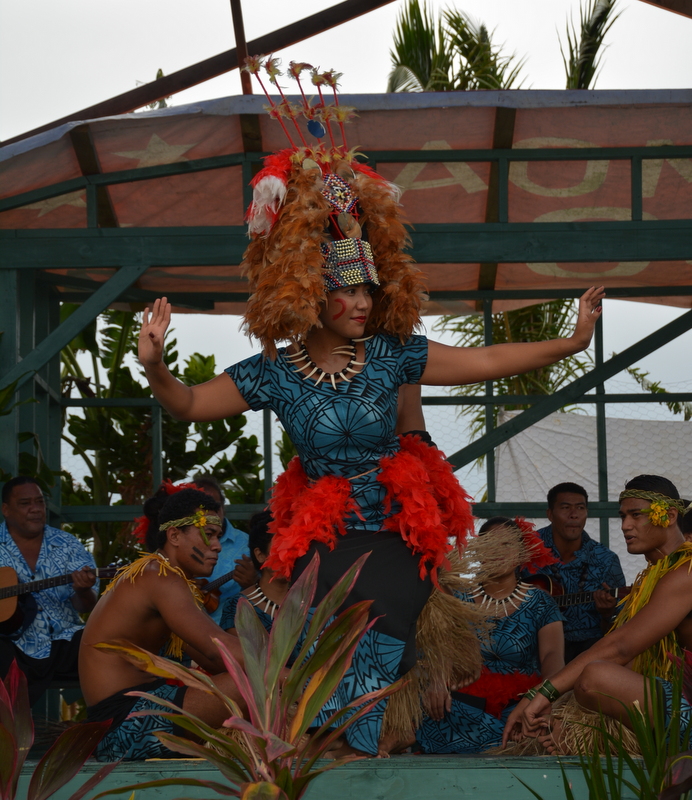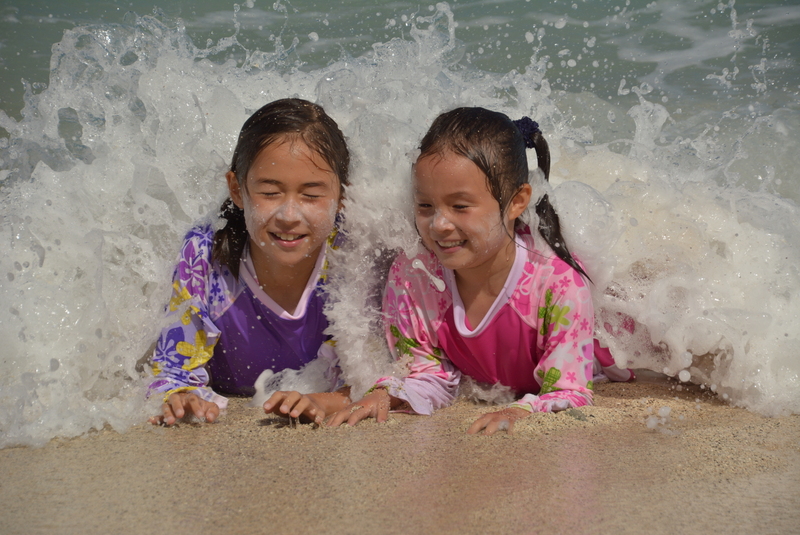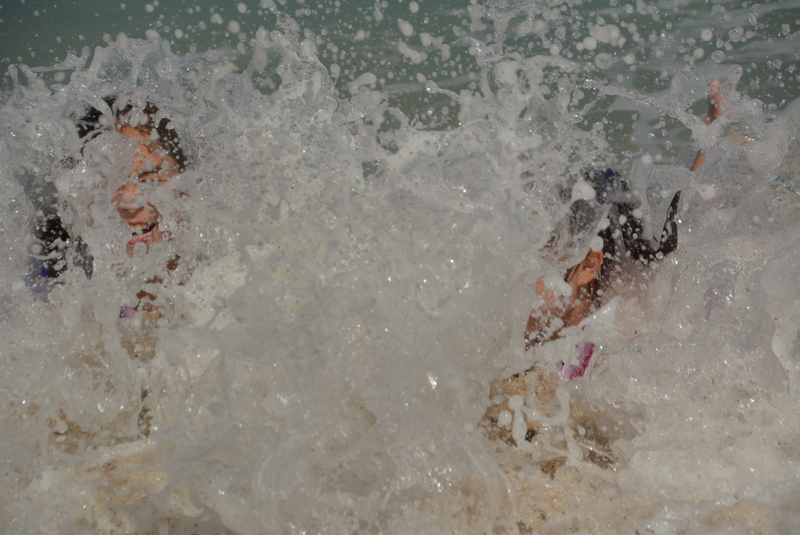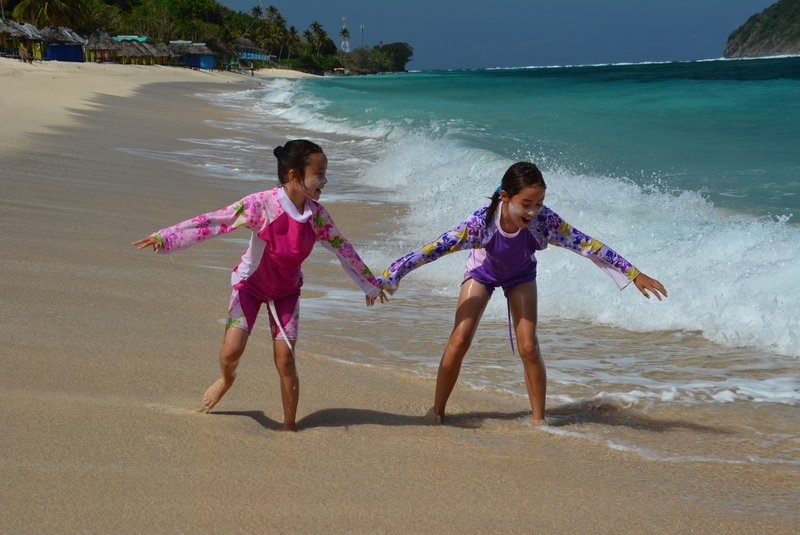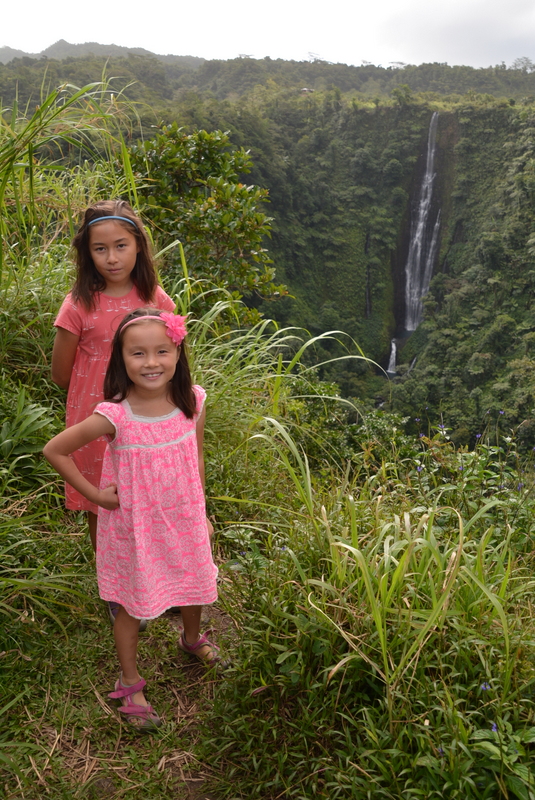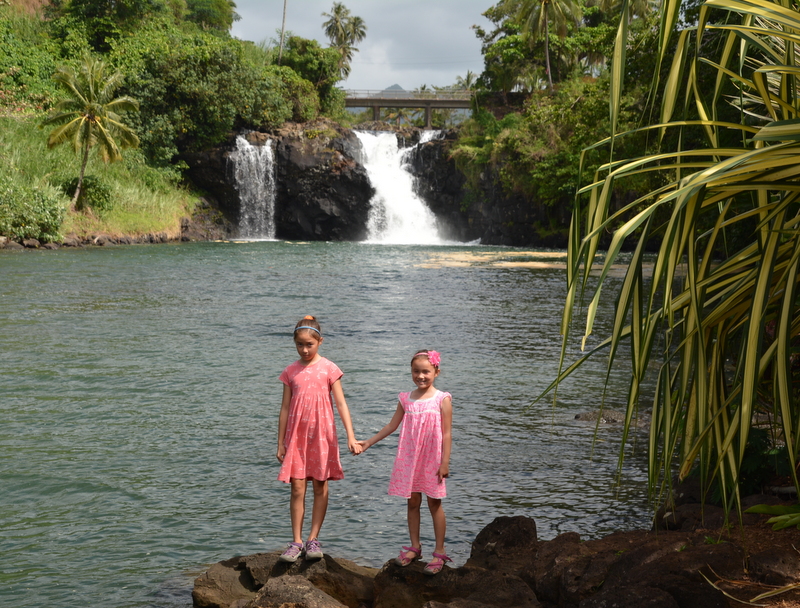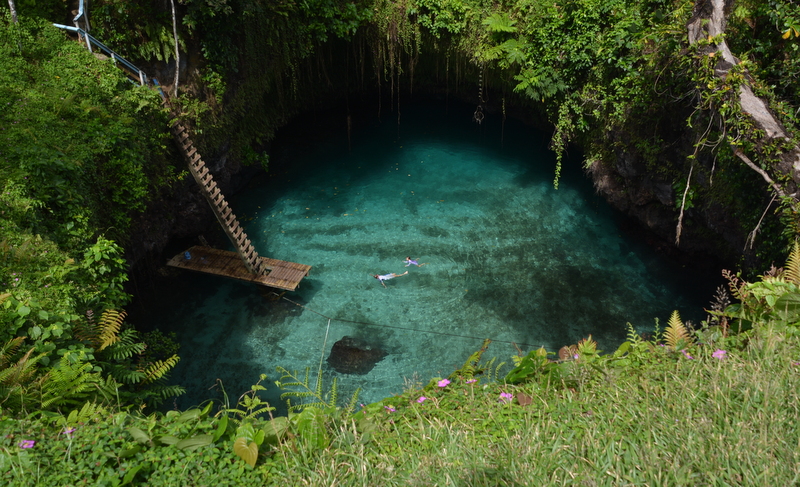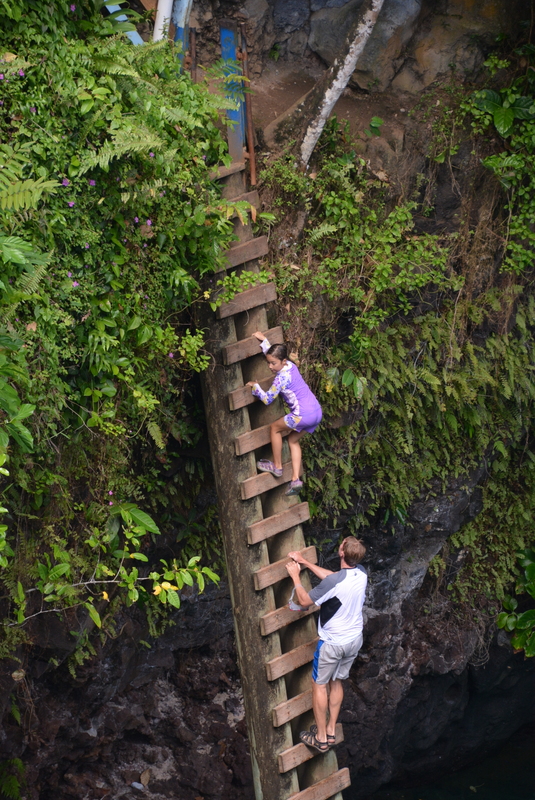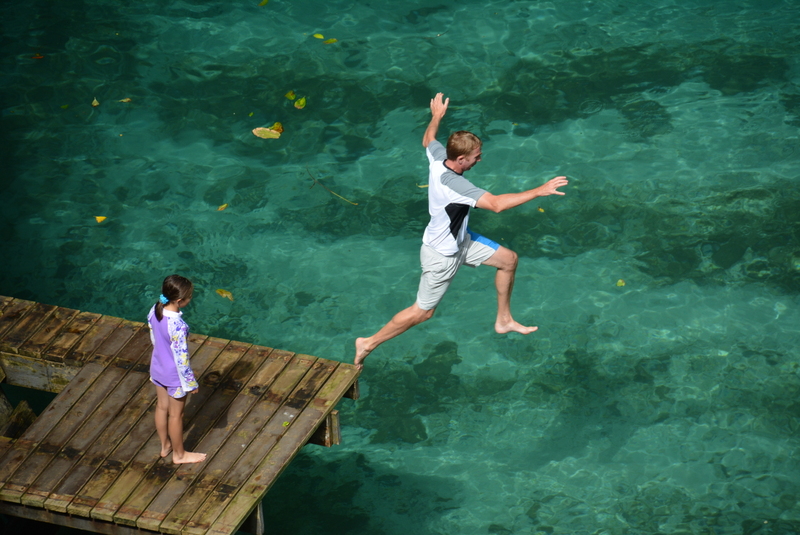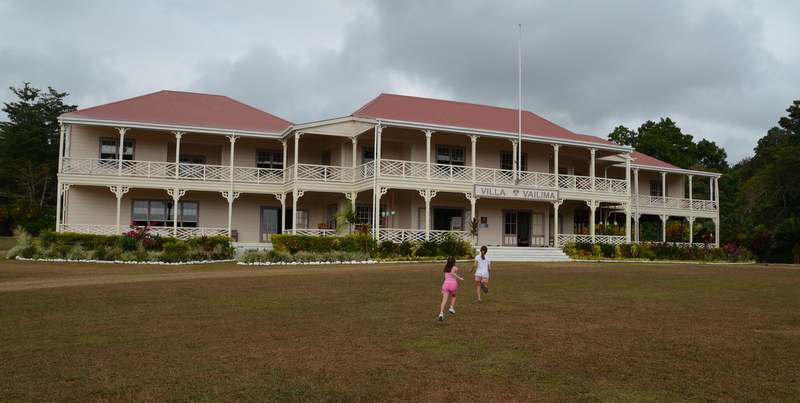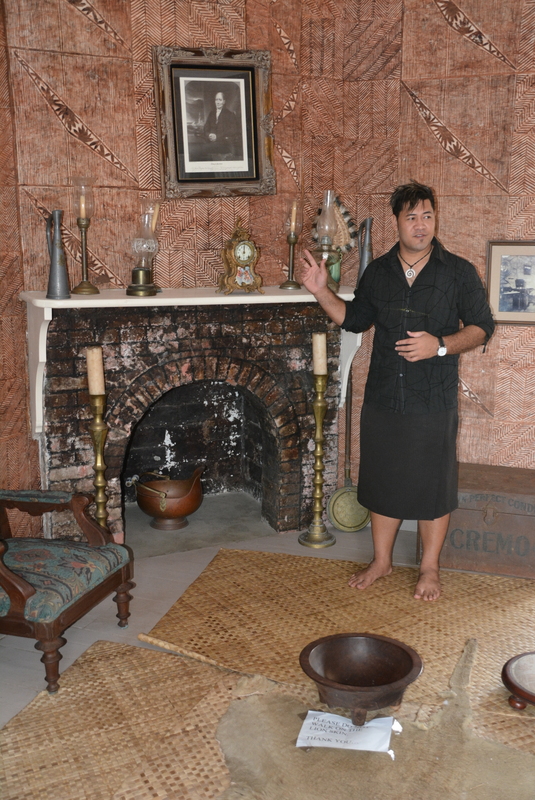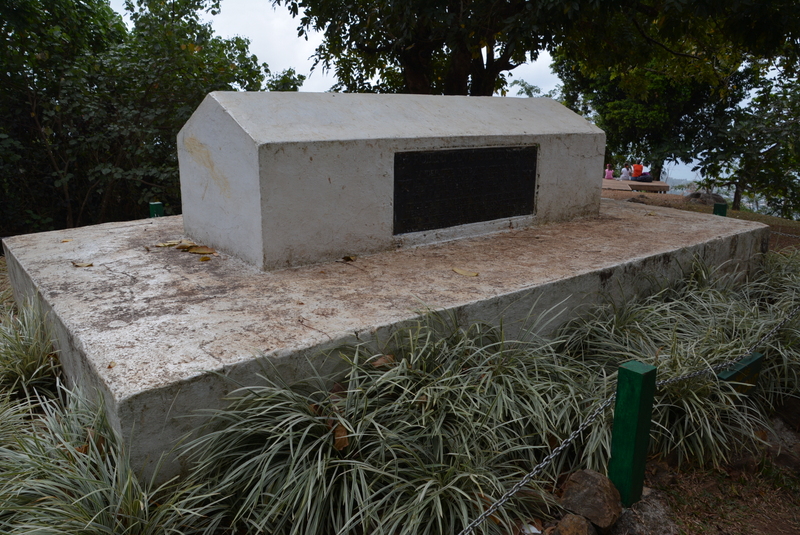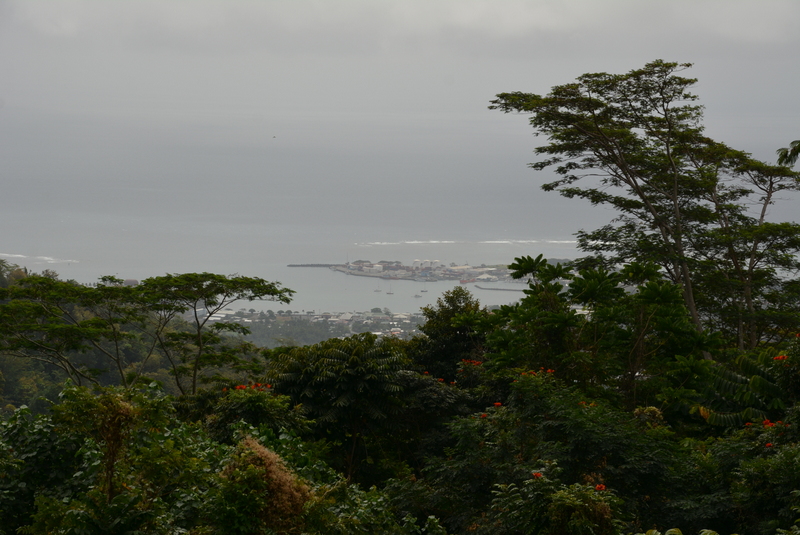- Boat
- Articles
- About
- Tehani-li Logs
- 2004
- Uligan Maldives
- Man, Oh Man, Oman
- Eritrea: The Nicest Place You’ve Never Heard Of
- Cruising Notes: Oman to Eritrea – From Pirates to Cappucinos
- Old Testament Sudan
- Egypt: Legend, Myth and Reality
- Thoughts on Cruising the Red Sea
- Greece: Civilization Again
- Montenegro
- Malta
- Sardinia, Italy
- Barcelona, Spain
- 2003
- 2002
- 2001
- 2004
- Contact
Jesus Loves Samoa
That is what the signs say and a huge church dominates the anchorage of Apia. The large people here are kind and easy going and the natural beauty that surrounds us is unsurpassed.
Our passage from Suwarrow to Samoa was a tough 536 nautical miles. We had to cross the feared South Pacific Convergence Zone, a large area of disturbed and disturbing weather caused by warm equatorial air meeting colder air masses that surge up from the Southern Ocean. The forbidding SPCZ lies like a police baton across the path of sailors who want to cross the South Pacific. Despite forecasts of “normal trade wind conditions” of 18 knots from behind, we enjoyed 25-35 knots steady, gusting into the 40s the entire trip. The swell kicked up to about a good 12 feet and at times it was “rough as guts,” as the New Zealanders say. Our teapot was unsecured and launched itself into the air causing the lid to smash into the floor and shatter. Ah well, a small price to pay for living the dream.
As luck would have it we arrived in Samoa at dawn on a Sunday. We followed the instructions of Port Control on the radio and anchored at the head of the bay which abuts the main town and capital of Apia. The nice Port Control officer says we can go into town as it is Sunday and there is nobody to process our clearance. The girls are quite eager to stretch their legs after four rolly days on the boat and we launch the dinghy. After tying up at the dock we encounter three security officers who tell us basically, no, we cannot leave the harbor without checking in to the country first. When I explain, yes, you see the harbor master told us it was alright they laugh. “No, he is only the night watchman.” Ooops. We stand there quietly wondering what to do. Everyone is very friendly. I am keen to keep it friendly and I carefully sigh as I point to the long faces of Asmara and Adriana. The nut-brown, barrel chested security guard with the reflective Terminator sunglasses is the man in control. I see him looking impassively at me and then at the sad faces of my girls. I wait feeling the silence sinking in.
“Oh,” he croaks in a small voice, “I have daughters too… Ok, you can go.”
Welcome to Samoa! I can already see why Jesus is so fond of this place.
A friendly taxi driver, Tusi, immediately latches on to us. He tells us where everything is and I thank him explain we will walk for the exercise but tomorrow we will avail ourselves of his services. There isn’t much to see but we are able to grab lunch at the only restaurant in the area that is open and we return to the boat tired but satisfied.
The next day dawned bright after a great sleep that required no night watches. We drove around town with Tusi in his small car running errands. We pass a Samoan man with his hair done up, wearing bright red lipstick and rouge. Sitting up front with Tusi I mention this to him.
“Tusi, that man over there is dressed as a woman.”
“Yup.”
“Is that considered unusual in Samoa?”
“Nope.”
“Ok.”
Apia, the capital of what was known as Western Samoa but now just calls itself Samoa, is the biggest town we have seen since Papeete. Still, with a population of just 36,000 one should not expect Broadway shows. However, the Samoa Cultural Center was a nice surprise and offered us a free lunch and dance show plus craft exhibits in individual fale, or traditional huts without walls. This turned out to be more than impressive.
The dancing here in Samoa seems gentler than that of French Polynesia and incorporates a lot of body slapping reminding me of the dance scene in Germany featuring Chevy Chase in the it’s-so-bad-it’s-good movie, “European Vacation.” The women wear much more chaste clothing than their Tahitian sisters and are fully covered in floral patterned gowns with flowers around the hips and in the hair while the men, as in the other islands, are barely dressed at all. The music is also totally different; soft and almost lullaby-like. The musicians behind the dancers featured three guitars, a ukulele, one guy on a tiny bamboo drum to keep time and a woman singer. They sounded like a mellow country music band which could play in an old folks home. In Tahiti they wheel out an entire percussion orchestra of 30 or more beefy guys who immediately begin thrashing their drums within an inch of their lives while the sweat is flying and maybe they have one guy with a ukulele. The dancing in Tahiti was fast and wild; the kind of stuff that brings the roof – rafters and all – down around your ears. Watching the gentle Samoans dance with their old folks music and thinking of the crazed Tahitians stopping heaven and earth was sort of like comparing a cupcake birthday candle to a lightning strike.
One of the fale was dedicated to tattooing and inside we found a Samoan woman getting a tattoo on the back of her thighs right in front of us. She was face down in a pillow writhing in pain as the tattoo assistants, all big men, held her down so she couldn’t move. Traditional tattoo artists are revered in Samoa and only those who have the proper bloodline are allowed to pursue the art. Our artist was a giant of a man covered in traditional tattoos and held the tattooing instrument. This was a thin bamboo stick about two feet long with a 90 degree bend at the end which was about four inches long. At the end of this bent portion was affixed a titanium needle. After a dip in green ink the man-mountain tattoo artist places the needle over the back of her thigh, takes another stick of bamboo and with it taps the first stick in a steady rhythm. Each tap causes the skin to be penetrated and deposits ink deep into the tissue. Tap-tap-tap-tap is the sound it makes, or ta-ta-ta-tau to the Polynesian ear which is how they get the word “tatau” and which becomes “tattoo” in English.
Before entering the fale we were told by our Samoan guide, one of the woman dancers we saw earlier, to respectfully remove all hats, sunglasses, headbands and shoes. We were told where to sit and where not to sit and where not to go. No speaking was allowed unless permission was given. Absolutely no photographs were allowed either. At question time one tourist predictably asked if he could get a Samoan tattoo. This caused the artist to look up, stop his work and nod. After a moment, he surveyed our motley crowd of a dozen or so whiteys and calmly intoned, “You Europeans,” He paused. “You get tattoos for fashion.” He paused again. “For Samoans it is not fashion. It is our culture.”
While we sitting there in a state of shock silently watching this real demonstration of real culture with a real woman in real pain, the Samoan Police Band suddenly strikes up a lively tune and begins marching across the street toward us. The guide in the fale is explaining how sacred tattoos are to Samoan culture while this huge oompah-pah band is marching closer and closer. She is raising her voice but otherwise gives the band no notice, nor do the tattoo people even look up but steadily continue their work. It is as if the marching band in full regalia is imaginary. The music is now deafening with cymbals crashing and drums booming as the band passes. All the while we don’t know whether to watch the woman wriggle in agony (“tap-tap-tap-tap”) or the quirky “Police Band” (“oompah, oompah”) as it proudly marches by. This is Samoa.
We drove to the spectacular “To Sua Ocean Trench,” which is not a trench at all but two lava sinkholes connected via an underground passage directly to the ocean. To reach the swimming area a vertiginous 60 foot ladder must be negotiated which is almost straight up and down. The water is crystal clear, about 12 feet deep and with a slight swell causing you to gently float to and fro in time with the waves outside. Descending the ladder to the bottom and looking up at the straight walls rising to the sky is like entering another dimension and Asmara and I, frogs is a large well looking up, were lucky to have the place to ourselves for a few precious minutes before more people arrived.
The upper sinkhole is connected to the main sinkhole by a passage with a rough lava ceiling about four to five feet above the water level. An older couple were floating on their backs in the shade here silently contemplating the ceiling above them and the wondrous surroundings. They looked serene. As Asmara and I swam outside in the big sinkhole they floated out into the sunlight toward us. Grandad looked peaceful and Granny was in bliss.
We did the same, floating on our backs with our arms and legs outstretched like giant starfish the swell gently sucked us out of the smaller sinkhole under the rough, melted cheese lava ceiling to the larger sinkhole. As we silently passed into the larger sinkhole and came under the edge of the wall and entered the light, water droplets fell here and there. It was magical to watch fifty to sixty feet above where the droplets formed on bright green plants or edges of the black lava wall and then released themselves plunging into space on their little adventures. They came one by one hurtling towards us and hitting the water with loud ker-plops. The boom of the surf outside could just be heard deep down in our little world. It seemed natural to speak in hushed tones in this sacred place.
A few car loads of loud European tourists arrived and they began climbing down the ladder. I figured our quiet, contemplative scene was soon to be disrupted and although I didn’t mind, I felt a little sorry for the older couple who were obviously relishing their peace and quiet. One guy in his mid-twenties paused on the landing at the top of the ladder. He looked like he wanted to jump the full 60 feet into the pool. Everyone stopped swimming and talking to watch him. He looked down. He looked up. He hesitated. He walked to the edge, stopped and looked down again. All of a sudden I hear behind me a feral Aussie accent shriek, “Yella! Yella! JUMP, mate!” Whirling around in the water and half-expecting to see Julia Gillard at my side I was astonished to see the quiet and sublime Granny with her hands cupped to her lips framing another primal scream, “Yella! Yella! JUMP, mate!!” When you have old ladies screaming at you in front of a crowd the best thing to do is comply. And he did.
Spell broken. It was time to leave. And we did.
Today we visited Vailima, the last home and resting place of Scottish author Robert Louis Stevenson. “RLS” is known today for his major works, such as “Treasure Island,” “Kidnapped,” and, “Dr. Jekyll and Mr. Hyde.” However, he was much more than a popular and wealthy author, Stevenson was a fearless humanist who rose to any occasion to defend native peoples across the Pacific. Holding enlightened views such as the rights of islanders and self-determination put him quite at odds with contemporary Western orthodoxy and other expats in Samoa.
Due to perennial health issues, Robert Louis Stevenson left Scotland in search of a better climate with his American wife, Fanny, and her two older children from another marriage. The Stevensons chartered a yacht and sailed across the planet’s greatest ocean from Polynesia up to Micronesia and down to Australia. They fell in love with Samoa and the people and decided to buy land and live here.
The only fireplace in Samoa:
Purchasing 400 acres of prime land on the shoulder of Mt. Vaea which enjoyed sweeping views of the town of Apia, the reef and the ocean beyond, they built the grandest house Samoa had ever seen. Stevenson named his wooden palace “Vailima,” or “Five Rivers” as he believed there were five streams on his property (there are apparently only three). It took two years to build and the family added many flourishes, such as imported redwood from Fanny’s native California to make her feel at home. After moving in, Stevenson frequently invited local Samoans to visit and dine with him. This was 125 years ago when the few Europeans here normally kept their own company and likely as not disdained contact with what were known as “the natives.” A natural storyteller, Stevenson entertained the people with many tales real and invented. They gave him the name “Tusitala,” or “Teller of Tales,” and hold his memory dear to this day. In fact, his house is featured on the local currency.
A low-key tour is given of the property by a Samoan guide. We stood in the study upstairs where RLS wrote some of his last works (“Catriona,” the sequel to “Kidnapped”) and which had fine views across the veranda to the land below. An early riser like myself, he described in a letter to a friend of his back in Scotland the day’s beginning at Vailima:
“The morning is such a morning as you have never seen; heaven upon earth for sweetness, freshness, depth upon depth of unimaginable colour, and a huge silence broken at this moment only by the far-away murmur of the Pacific and the rich piping of a single bird. You can’t conceive what a relief this is; it seems a new world.”
Sadly, his poor health caught up with him and Robert Louis Stevenson died of a stroke in Vailima just two years after moving in at the too-young age of 44. Upon hearing the news of his sudden death one of the high chiefs in an immortal quote exclaimed, “Our beloved Tusitala. The earth and the stones weep.”
It was Stevenson’s wish to be buried at the top of Mt. Vaea and as the body needed to be interred twelve hours after expiring due to the climate a group of Samoans hacked out a trail through the thickest jungle imaginable from the house up to the top of the mountain. He is buried there. We hiked that trail today and are exhausted. The fact that forty Samoans carved this steep track out of the jungle using just iron hand tools and in one night is a testament to the regard they held for “Tusitala,” as well as the phenomenal physical strength of the people here.
“Under the wide and starry sky,
Dig the grave and let me lie.
Gladly did I live and gladly die,
And I laid me down with a will.
This be the verse you grave for me;
Here he lies where he longed to be;
Home is the sailor, home from the sea,
And the hunter home from the hill.”
This is what is on his grave. However, always aware that death haunted his every move, 15 years before he died Stevenson wrote another requiem which is not on the tomb and which I take from Gavin Bell’s book, “In Search of Tusitala”:
“You, who pass this grave, put aside hatred; love kindness; be all services remembered in your heart, and all offences pardoned; and as you go down again among the living, let this be your question: can I make someone happier this day before I lie down to sleep? Thus the dead man speaks to you from the dust: you will hear no more from him.”
Words to keep for the living from the soul of a dead poet.

